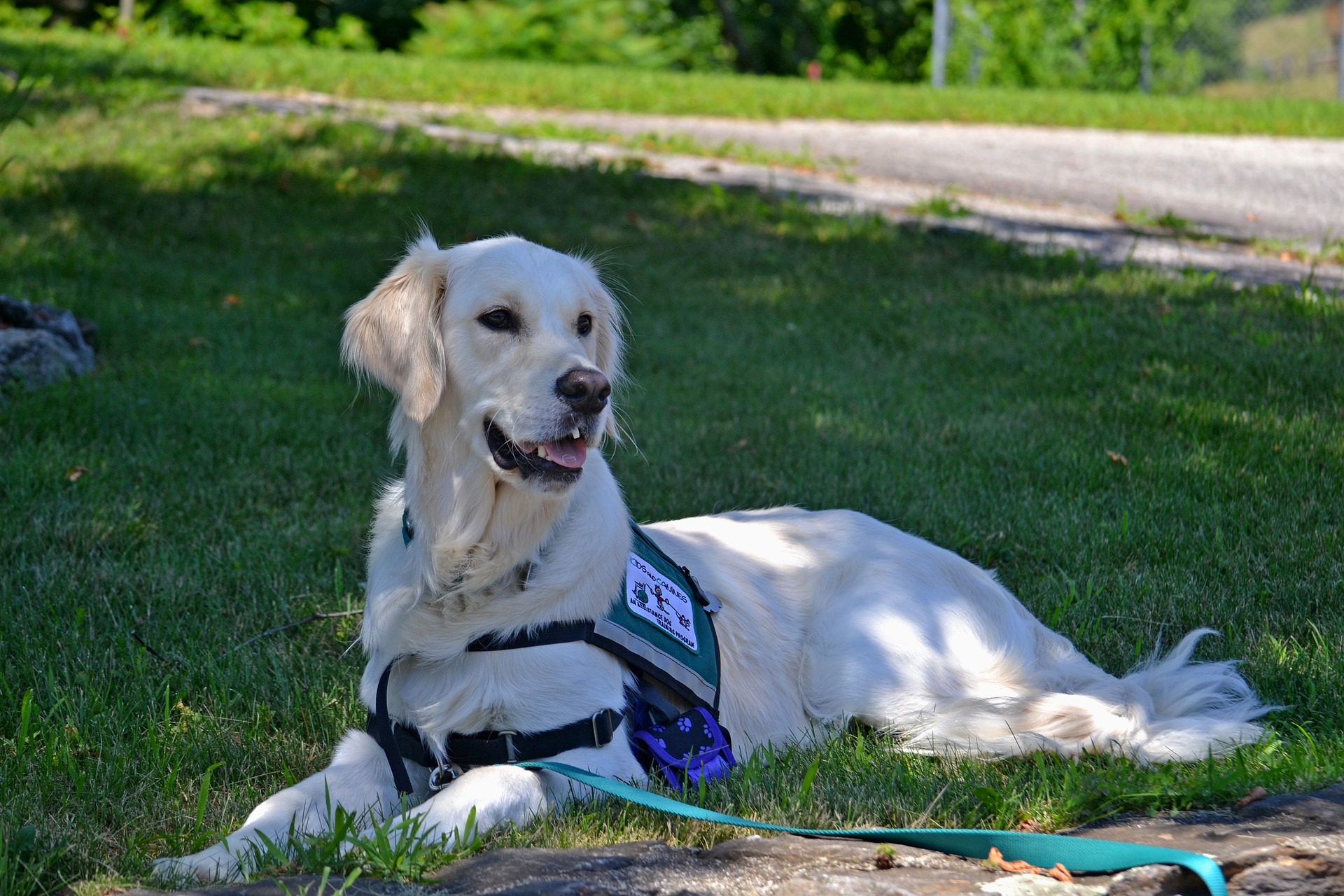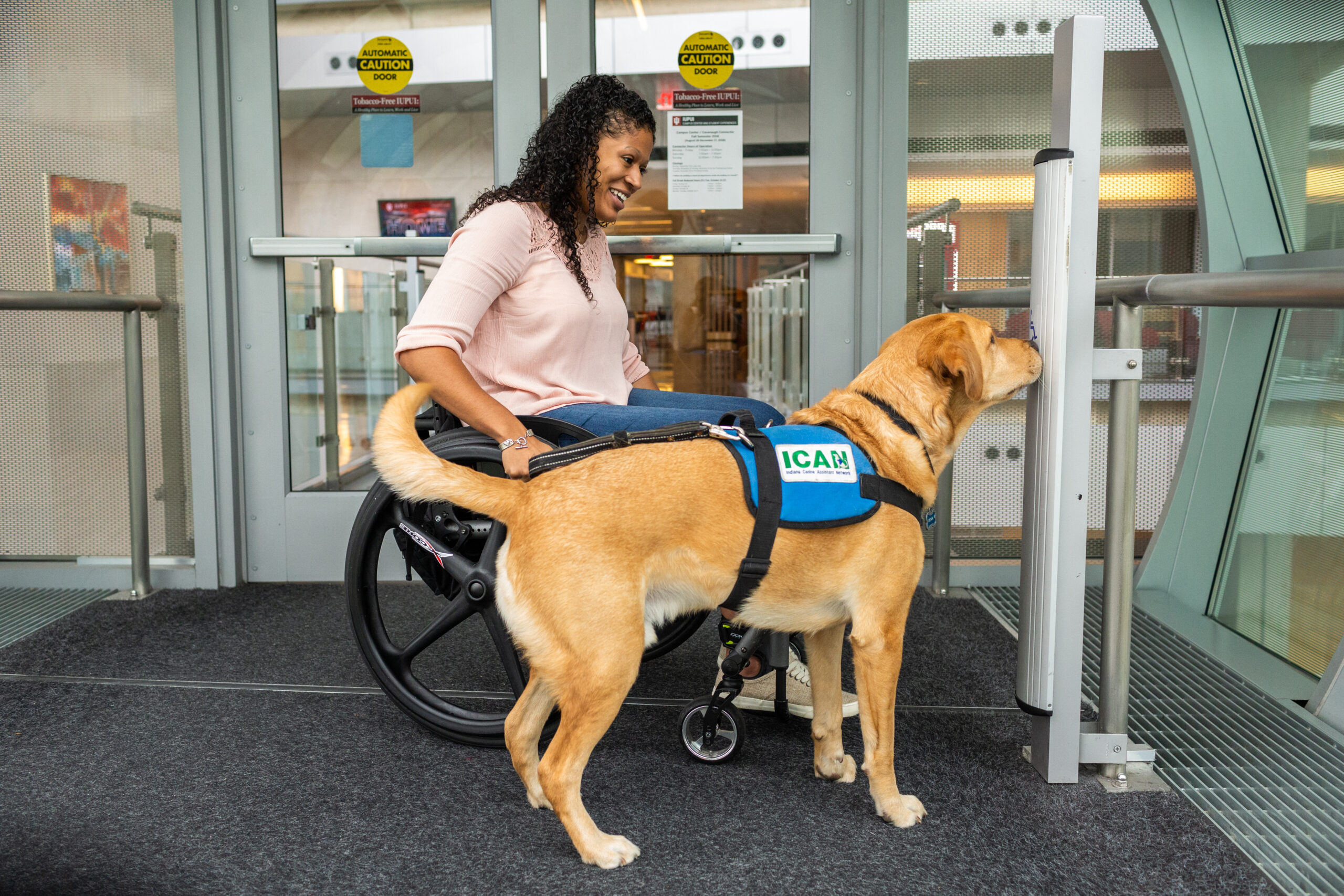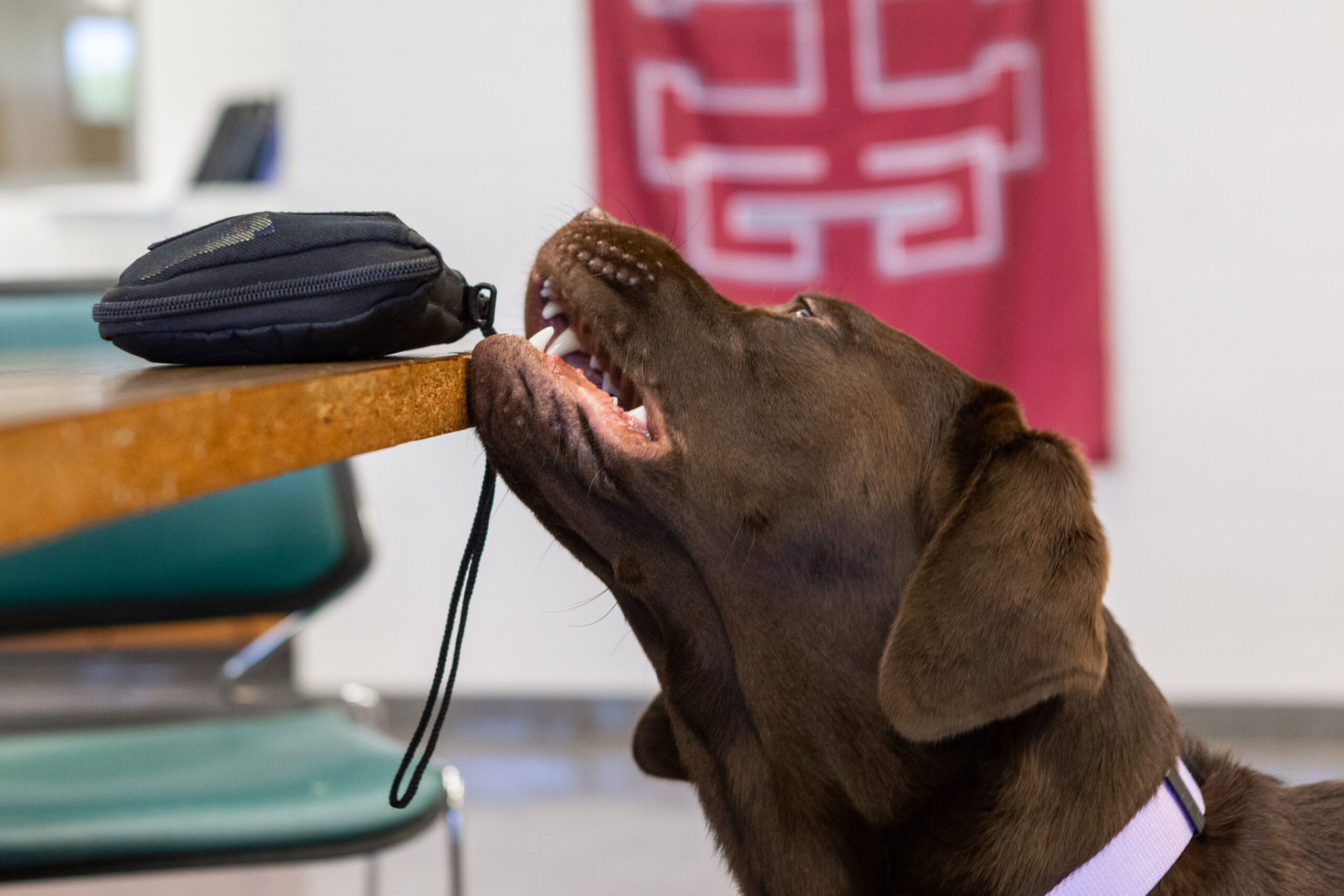Service dogs are specially trained dogs that perform specific tasks for people with disabilities. They play a vital role in the lives of people with disabilities, ranging from autism to muscular dystrophy.
These loving animals help their owners perform day-to-day tasks, and some are specially trained for people with diabetes, epilepsy, or PTSD. Service dogs play an important practical role in the lives of their partners, but they also become loving friends.
You are reading: 9 Types Of Service Dogs
In this article, we will define what a service dog is, review common breeds used, and examine the types of service dogs available. We will also review the benefits of service dogs for people with disabilities.

9 Types Of Service Dogs
Guide Dogs

Guide dogs are a type of service dog that assist people who are visually impaired or blind. These dogs are trained to lead their handlers around obstacles and help them navigate their surroundings safely.
Guide dogs are typically trained to stop at curbs, stairs, and other obstacles, and to move forward when it is safe to do so. They also learn to follow directional commands, such as “left,” “right,” and “forward”.
Guide dogs are typically trained by organizations that specialize in service dog training, such as Guide Dogs for the Blind and Guide Dogs of America.
These organizations rely on volunteers to raise and socialize puppies before they begin their formal training. Once the puppies are old enough, they begin their training, which can take several months to a year or more.
Guide dogs are typically medium to large breeds, such as Golden Retrievers, Labrador Retrievers, and German Shepherds. These breeds are chosen for their intelligence, trainability, and temperament. Guide dogs are trained to be calm, obedient, and focused on their handler.
Overall, guide dogs play a crucial role in the lives of people who are visually impaired or blind. They provide their handlers with independence, mobility, and companionship.
Hearing Dogs
Hearing dogs are a type of service dog that are trained to assist people who are deaf or hard of hearing by alerting them to important sounds, such as doorbells, smoke alarms, ringing telephones, or alarm clocks.
These dogs are trained to recognize a particular sound and then physically alert or lead their handler to the source. They may also be taught to physically alert to and/or lead away from a sound, such as in the case of a fire alarm.
Hearing dogs are typically trained professionally in as little as three months, though many are trained for at least a year. They are tested for proper temperament, sound reactivity, and willingness to work before they begin their formal training.
After passing initial screenings, they are trained in basic obedience and exposed to things they will face in public areas, such as elevators, shopping carts, and different types of people.
Hearing dogs can be trained to respond to American Sign Language for people who are non-verbal. They can also be taught to perform tasks related to a seizure disorder or physical disability.
Some breeds notable for selection as hearing dogs include Golden Retrievers, Poodles, Cocker Spaniels, Labrador Retrievers, Australian Shepherds, and Cockapoos. Hearing dogs are legally permitted access to any locations that are open to members of the public, so long as they are with their handler.
Overall, hearing dogs play a crucial role in the lives of people who are deaf or hard of hearing. They provide their handlers with independence, safety, and companionship.
Mobility Assistance Dogs

Mobility assistance dogs are a type of service dog that are trained to help people with mobility issues, such as poor balance or being a non-ambulatory wheelchair user. These dogs are trained to provide balance and stability, pick up and carry objects, pull wheelchairs, open and close doors, and operate light switches.
Mobility assistance dogs can have a significant positive impact on the lives of their handlers by providing them with greater independence and mobility.
Mobility assistance dogs are trained to perform a variety of tasks, including:
– Providing balance and stability
– Picking up and carrying objects
– Pulling wheelchairs
– Opening and closing doors
– Operating light switches
– Counter-balancing for Parkinson’s disease and multiple sclerosis patients
– Retrieving dropped items
– Turning lights on and off
– Finding other people in the house when help is necessary
Mobility assistance dogs are trained to respond directly to their handler, with the ability to independently implement tasks in challenging and distracting environments. They are trained to perform jobs well even in stressful situations where their handler may fully rely upon them.
Mobility assistance dogs are trained by organizations that specialize in service dog training, such as Canine Partners for Life and 4 Paws for Ability. These organizations rely on volunteers to raise and socialize puppies before they begin their formal training. Once the puppies are old enough, they begin their training, which can take several months to a year or more.
Mobility assistance dogs are typically medium to large breeds, such as Labrador Retrievers, Golden Retrievers, and German Shepherds. These breeds are chosen for their intelligence, trainability, and temperament. Mobility assistance dogs are trained to be calm, obedient, and focused on their handler.
Read more : 10 Types Of Japanese Dog Breeds
Overall, mobility assistance dogs play a crucial role in the lives of people with mobility issues. They provide their handlers with independence, mobility, and companionship.
Seizure Alert Dogs
Seizure alert dogs are a type of service dog that are trained to detect and respond to seizures in their handlers. These dogs can be trained to perform a variety of tasks, including alerting family members or activating a call system during a seizure, lying next to the person having a seizure to comfort or protect them, and finding help when necessary.
Some seizure alert dogs may also be trained to predict seizures by detecting specific behaviors that occur before a seizure, although this is rare and not fully understood.
Seizure alert dogs are trained by organizations that specialize in service dog training, such as Canine Partners for Life and PAWS with a Cause.
These organizations rely on volunteers to raise and socialize puppies before they begin their formal training. Once the puppies are old enough, they begin their training, which can take several months to a year or more.
Seizure alert dogs can be trained to perform a variety of tasks, including:
– Alerting family members or activating a call system during a seizure
– Lying next to the person having a seizure to comfort or protect them
– Finding help when necessary
– Retrieving medications or food after a seizure
– Acting as a brace to help the person up after a seizure
– Providing comfort and support during and after a seizure
Seizure alert dogs are typically medium to large breeds, such as Golden Retrievers, Labrador Retrievers, and German Shepherds. These breeds are chosen for their intelligence, trainability, and temperament. Seizure alert dogs are trained to be calm, obedient, and focused on their handler.
Overall, seizure alert dogs play a crucial role in the lives of people with epilepsy. They provide their handlers with independence, safety, and companionship.
Seizure Response Dogs
Seizure response dogs are a type of service dog that are trained to perform specific behaviors during or after a seizure. This might include barking to alert family members when someone is having a seizure or activating a call system.
Other dogs may learn to lie next to the person having a seizure to comfort or protect them. Seizure response dogs can be trained to stay close to their companions for the duration of the seizure, as well as fetch medications, a telephone or caretaker.
Seizure response dogs are different from seizure alert dogs, which are trained to detect and respond to seizures before they occur. Seizure alert dogs can be trained to perform a variety of tasks, including lying next to someone having a seizure to prevent injury, placing their body between the handler and the floor to break a fall at the beginning of a seizure, staying with the handler during a seizure to provide support and comfort, and activating a call system.
Seizure alert dogs are trained to detect and respond to the signs of an oncoming seizure, providing valuable assistance during and after the event. Seizure response and seizure alert dogs are trained by organizations that specialize in service dog training, such as PAWS with a Cause and Medical Mutts Service Dogs Inc.
These organizations rely on volunteers to raise and socialize puppies before they begin their formal training. Seizure response and seizure alert dogs are typically medium to large breeds, such as Golden Retrievers, Labrador Retrievers, and German Shepherds. These breeds are chosen for their intelligence, trainability, and temperament.
Seizure response and seizure alert dogs are trained to be calm, obedient, and focused on their handler.
Diabetic Alert Dogs

Diabetic alert dogs are a type of service dog that are trained to detect high or low levels of blood sugar in people with diabetes and alert their owners to dangerous changes in blood glucose levels.
These dogs are trained to detect the chemical changes in their owner’s body when their blood sugars are rapidly rising or falling, which is undetectable to humans.
Diabetic alert dogs can detect blood glucose changes using the saliva of diabetic patients. The diabetic person collects samples using gauze or dental cotton during a time when their blood sugar is just starting to get too low or too high.
Samples must be collected when the patient has not eaten within 30 minutes, brushed their teeth, or used anything with a strong smell such as mouthwash to get the strongest scent for diabetes alert.
Diabetic alert dogs are trained to alert their owners to changes in blood sugar levels by performing a predetermined task, such as barking, laying down, or sitting.
Dogs may be directly smelling something related to the abnormal glucose concentration or may be reacting to the owner’s symptoms which are caused by hypoglycemia, such as sweating or shaking.
Diabetic alert dogs are trained by organizations that specialize in service dog training, such as Diabetic Alert Dogs of America and Medical Mutts Service Dogs Inc.
These organizations rely on volunteers to raise and socialize puppies before they begin their formal training. Once the puppies are old enough, they begin their training, which can take several months to a year or more.
Diabetic alert dogs are typically medium to large breeds, such as Golden Retrievers, Labrador Retrievers, and Poodles. These breeds are chosen for their intelligence, trainability, and temperament. Diabetic alert dogs are trained to be calm, obedient, and focused on their handler.
Overall, diabetic alert dogs play a crucial role in the lives of people with diabetes. They provide their handlers with independence, safety, and companionship.
Psychiatric Service Dogs
Psychiatric service dogs are a type of service dog that are trained to assist people with mental health conditions, such as depression, anxiety, bipolar disorder, PTSD, and panic attacks.
Read more : Why Does my Dog Wrap His Paws Around My Arm
These dogs are trained to perform specific tasks that help their owners manage their symptoms and function more effectively in daily life. Psychiatric service dogs can be any breed of dog or any size, as long as the dog is able to accompany the owner to public places.
Psychiatric service dog training can be done by the owner, but usually, these dogs are individually trained by organizations that specialize in service dog training, such as Medical Mutts Service Dogs Inc and Little Angels Service Dogs.
These organizations rely on volunteers to raise and socialize puppies before they begin their formal training. Once the puppies are old enough, they begin their training, which can take several months to a year or more.
Psychiatric service dogs can be trained to perform a variety of tasks, including:
– Alerting their owner to an impending panic attack or anxiety episode
– Interrupting destructive behaviors associated with mental health conditions
– Providing comfort and support during and after a panic attack or anxiety episode
– Retrieving medication or water for their owner
– Providing deep pressure therapy to help calm their owner
– Waking their owner from nightmares or night terrors
– Providing a sense of security and companionship
Psychiatric service dogs are trained to be calm, obedient, and focused on their handler. They are trained to respond directly to their handler, with the ability to independently implement tasks in challenging and distracting environments.
Psychiatric service dogs are legally permitted access to any locations that are open to members of the public, so long as they are with their handler.
Overall, psychiatric service dogs play a crucial role in the lives of people with mental health conditions. They provide their handlers with independence, safety, and companionship.
Allergy Detection Dogs
Allergy detection dogs are a type of service dog that are trained to detect allergens and alert their owners to their presence. These dogs can be trained to detect a variety of allergens, including peanuts, gluten, and Red Dye 40. Allergy detection dogs are trained to detect allergens by using their sense of smell.
Allergy detection dogs are trained by organizations that specialize in service dog training, such as Allergen Detection Service Dogs and Nosey Dog Detection Partners. These organizations rely on volunteers to raise and socialize puppies before they begin their formal training. Once the puppies are old enough, they begin their training, which can take several months to a year or more.
Allergy detection dogs can be a game changer for their owners, especially those with severe contact or respiratory anaphylaxis. These dogs are able to smell even the slightest traces of potential allergens, providing their owners with a sense of security and safety.
It is important to note that allergy detection dogs are trained to detect allergens, not the onset of an anaphylactic reaction. To date, there are no known instances of dogs that have been trained to detect the onset of an anaphylactic reaction.
Overall, allergy detection dogs play a crucial role in the lives of people with severe allergies. They provide their handlers with independence, safety, and companionship.
Autism Support Dogs
Autism support dogs are a type of service dog that are trained to assist people with autism spectrum disorder (ASD). These dogs can provide help, companionship, and social facilitation to people with ASD, helping them cope with difficult situations, transitions, and anxiety.
Autism support dogs can be trained to perform a variety of tasks, including:
– Interrupting repetitive behaviors
– Alerting the handler when they might be harming themselves
– Providing deep pressure to help calm the handler
– Encouraging the handler to get out of bed
– Helping with mobility or balance issues
– Picking up objects
– Responding to an alarm
– Facilitating social interactions and relationships
– Expanding the handler’s ability to communicate with others
Autism support dogs can be trained by organizations that specialize in service dog training, such as 4 Paws for Ability and Medical Mutts Service Dogs Inc. These organizations rely on volunteers to raise and socialize puppies before they begin their formal training. Once the puppies are old enough, they begin their training, which can take several months to a year or more.
Autism support dogs can be any breed of dog or any size, as long as the dog is able to accompany the owner to public places. A well-trained family pet can also be a wonderful calming influence for someone who has autism.
Overall, autism support dogs play a crucial role in the lives of people with ASD. They provide their handlers with independence, safety, and companionship.
FAQS
1. What is a service dog?
A service dog is a type of working dog that is trained to perform specialized tasks for people with disabilities or medical/mental health conditions.
2. What are the different types of service dogs?
The most common types of service dogs include guide dogs, hearing dogs, mobility assistance dogs, seizure alert/response dogs, diabetic alert dogs, psychiatric service dogs, allergy detection dogs, and autism support dogs.
3. What breeds are commonly used for service dogs?
Common breeds used for service dogs include Labrador Retrievers, Golden Retrievers, German Shepherds, Poodles, Border Collies, and Bernese Mountain Dogs.
4. Can any breed of dog be a service dog?
Yes, any breed of dog can be a service dog as long as they are trained to perform specific tasks for their handler.
5. What tasks can a service dog perform?
Service dogs can be trained to perform a variety of tasks, depending on the needs of their handler. These tasks can include providing balance and stability, alerting to sounds or smells, retrieving objects, opening and closing doors, and providing comfort and support during and after a medical event.
6. Are service dogs allowed in public places?
Yes, service dogs are allowed in public places, including restaurants, libraries, and public transportation. They have full public access rights under the Americans with Disabilities Act (ADA).
7. Can service dogs be refused access to a facility based on their breed?
No, individuals with disabilities cannot be refused access to a facility based solely on the breed of their service animal. The ADA does not restrict the type of dog breeds that can be service animals.
8. How are service dogs trained?
Service dogs are typically trained by organizations that specialize in service dog training. These organizations rely on volunteers to raise and socialize puppies before they begin their formal training. Once the puppies are old enough, they begin their training, which can take several months to a year or more.
9. How do I get a service dog?
To get a service dog, you must have a disability or medical/mental health condition that requires the assistance of a service dog. You can contact a service dog organization to inquire about their application process and requirements.
Source: https://petstutorial.com
Category: DOGS










